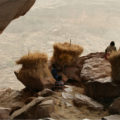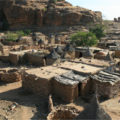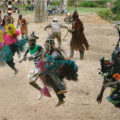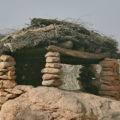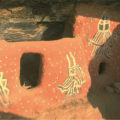A Russian Expedition to the Land of Mali
The Cliff of Bandiagara in the Republic of Mali has been on the UNESCO World Heritage List since 1989. For several years, Russian scientists have been studying the traditions and culture of the Dogon people.
A research expedition of the Institute of Oriental Studies of the Russian Academy of Sciences (RAS) has been working in the Republic of Mali since 2015, and since 2017, employees of the State Museum of Oriental Art (Moscow) have been taking part in it as well. Russian anthropologists and art historians are busy studying traditional Dogon culture and its changes in the modern world. The scientists have been also collecting objects of art and ethnography to replenish the collections of the Peter the Great Museum of Anthropology and Ethnography (the Kunstkamera) of RAS.
Sparesly vegetated Bandiagara Cliff (Dogon Plateau) drops abruptly into the Seno Valley. This cliff stretches along the Seno Valley for over a hundred kilometers from SW to NE. In places it is cut through by gorges with deep grottoes, interspersed with stone spurs protruding into the valley. There is really something mystical in this landscape: there you get the feeling that you are looking into the grayest depths of time, at the earth, which is still “without form and void”.
Ancestors of the modern Dogon came to the Escarpment in several waves. The first was around the 10th century, from the territory of modern Burkina Faso. Around the 12th century came the second wave. The last recorded migration dates back to the 70s of the 19th century. According to tradition, these people came from the Land of Manden, a vast territory in the west of Mali stretching from the border of Mauritania to the Niger River.
The newcomers settled in the Escarpment and valleys at its foot. They partly inherited the culture of Tellem people who had been living here since the 10–12th centuries and had a developed agriculture. The architecture of the Tellem settlements was well determined by their habitat: their adobe buildings on a frame made of thin wooden beams are molded in narrow strips on a steep cliff of the plateau above the Dogon buildings. Long before Tellem, Toloy people used to live here — their tiny barrel-shaped buildings can be seen even higher than the abandoned Tellem villages.
Their descendants are still talking about events that forced their ancestors to move from fertile Land of Manden to this harsh land. Historical tradition serves as a spiritual support and a unifying factor for all Dogon, although each village has its own stories of its past. The Dogon culture was formed as a uniquely diverse fusion of ethnic and social groups speaking about thirty languages. They preserve family, clan, and village histories as an indestructible whole. At the same time, the Dogon maintain good-neighborly relations with other peoples of Mali: the rules of traditional etiquette common to the whole country include a mechanism for resolving conflicts — “comic kinship”, which transforms conflicts into a playful form, thus removing acuteness of any problem. At home it looks like continuous banter and teasing each other. A victim of such teasing can also be a European, and the more they like him, the more they will scoff at him.
Humor pervades the life of a traditional Dogon village. For example, in the village of Ende, many crafty stories are told, completely Nikolai Gogol in spirit (famous Russian whiter). So, next to the Koranic school there is a “bewitched place”: once a very important old man wanted to dance there, but was not able to, and everyone understood that this place was not good. They say that if you walk through it, misfortune will happen, but only to those who know about its harmful properties. If some unlucky tourist wanders there who does not know about it, then nothing will happen. As a result, nothing bad happens in the village: those who know about witchcraft do not come close, as to tourists, they are off the hook. Evil tongues claim that earlier it was a place of pagan sacrifices …
Dogon villages are full of arts and crafts created according a living artistic tradition. Toguns, doors, shutters and bolts are decorated with skillful carvings. In houses, you can often find wooden sculpture and artwork made of metal cherished both as a memory of their ancestors and as purely art. Contrary to widespread claims about the degeneration and death of traditional art, there is a developed market of sculpture for their own. The market is going through hard times — because of the war, there are almost no tourists in Mali. There is still a demand for works of art because many Dogons continue to adhere to traditional beliefs, and some Muslims are returning to the religion of their ancestors.
The work of the expedition has long gone beyond the original task of verifying the information contained in the “classical” works of the ethnological school. When in contact with a living, diverse culture, an ethnologist, anthropologist and art historian constantly finds himself in a stream of new and sometimes completely unexpected information that cannot be contained within the framework of scientific publications. Being involved in the ups and downs of modern Dogon life, we receive a lot of information about cuisine, marriage customs, ways of resolving conflict situations, peculiarities of local humor, specifics of nature management, subtleties of local politics — the very “spirit” of Dogon culture.
The history of the settlement of the Dogon along the Bandiagara Escarpment is gradually becoming clearer — the puzzle of oral historical legends of individual villages, step by step, is being formed into a coherent mosaic. A variety of material has already been collected about the development of artistic tradition. We identify the stylistic features of the visual arts of different villages and, where possible, of individual artists; we fix the changes taking place now within traditional art under the influence of the art market.
An interesting example of the current situation is that some pieces of art offered to expedition members as “old” are made nowadays. Craftsmen respond to the challenges of the time in different ways: they creatively rework traditional forms, change them or copy famous works. The range of things that are being offered to tourists and collectors shows how Dogons perceive the European consumer of their art. Brilliant copyists from the Dogon hinterland demonstrate an excellent knowledge of museum collections, and also clearly have truly old things. They accurately reproduce the methods of forging and modeling of sculptural forms that have already became a matter of the past. Often, the only way to establish the true age of such copies is by radiocarbon analysis, which is carried out in cooperation with the radiocarbon dating laboratory of the Institute of Geography of the Russian Academy of Sciences.
Establishing trusting relationships with the villagers made it possible to touch upon some topics that are painful for the Dogon concerning the protection of their cultural heritage. Some sculptures (usually old ones) are kept in many villages, which are the most valuable for the entire village because of their history and ritual practices. Unfortunately, now more and more ritual objects are being stolen, which indicates a high demand for Dogon antiques.
Therefore, it is very important to study the functioning principles of the modern art market, wherein art and religious objects go from one owner to another locally, as well as outside the country. Apparently, there are several levels to this market: the most valuable objects remain in the villages, slightly less valuable ones are offered for purchase to people with a good reputation in the eyes of the owners; the rest goes to the capital and major cities, and from there abroad.
Unfortunately, an artifact that has changed many owners and is exhibited at a European auction almost always loses its history. That is why fieldwork remains the preferred way of replenishing museum collections with objects of African art, which allows collecting as much information as possible about a piece and its creators, as well as about peculiarities of its use.
Darya Vanyukova, State Museum of Oriental Art
Peter Kutsenkov, Institute of Oriental Studies of RAS

